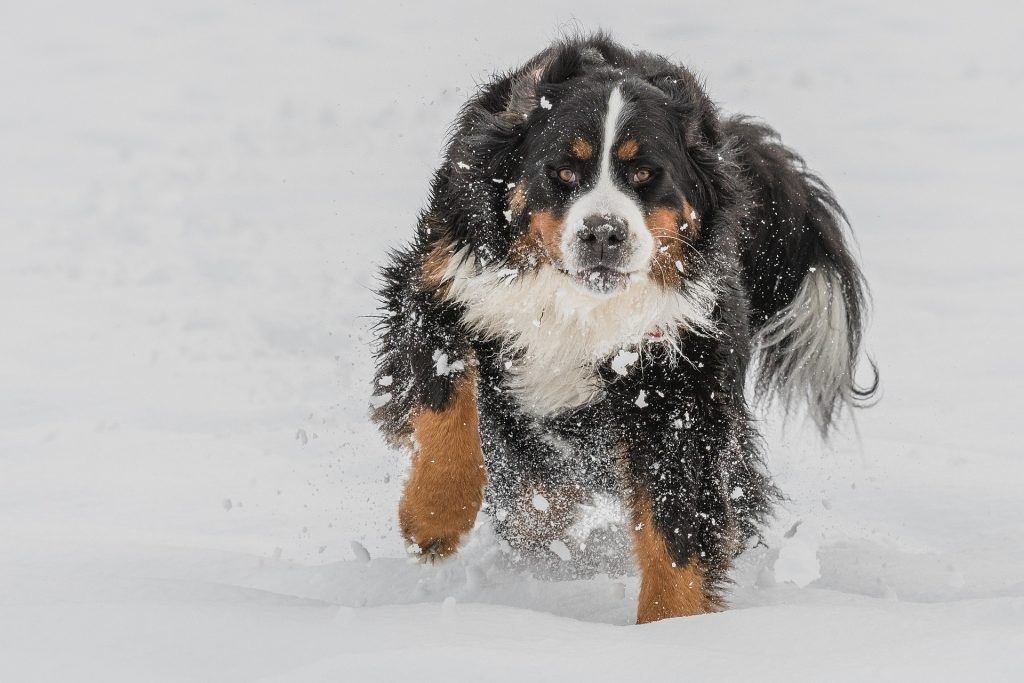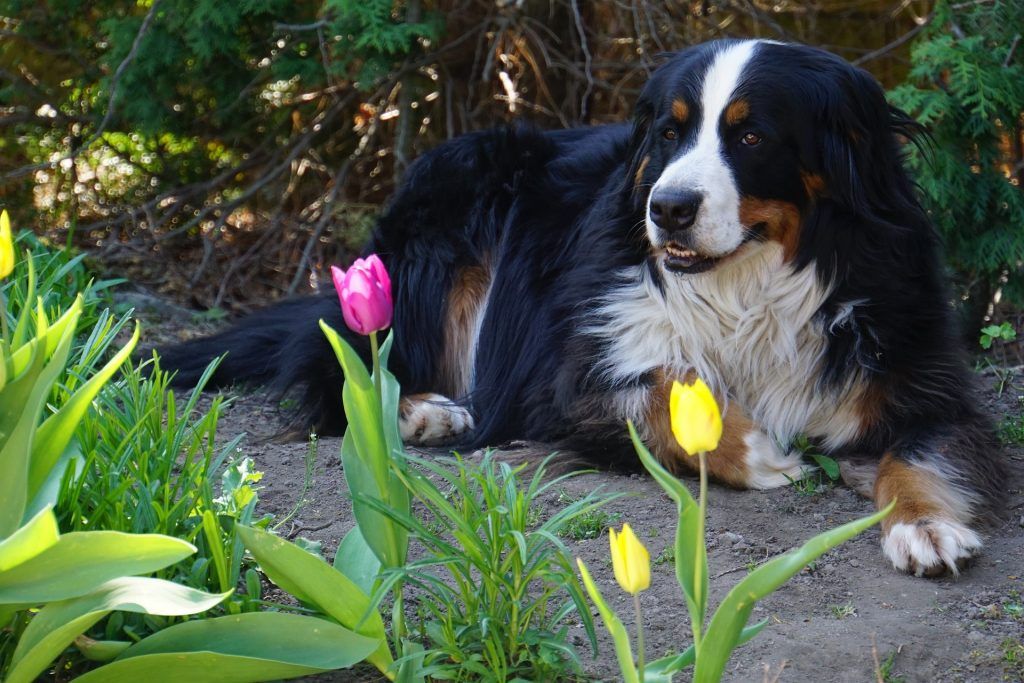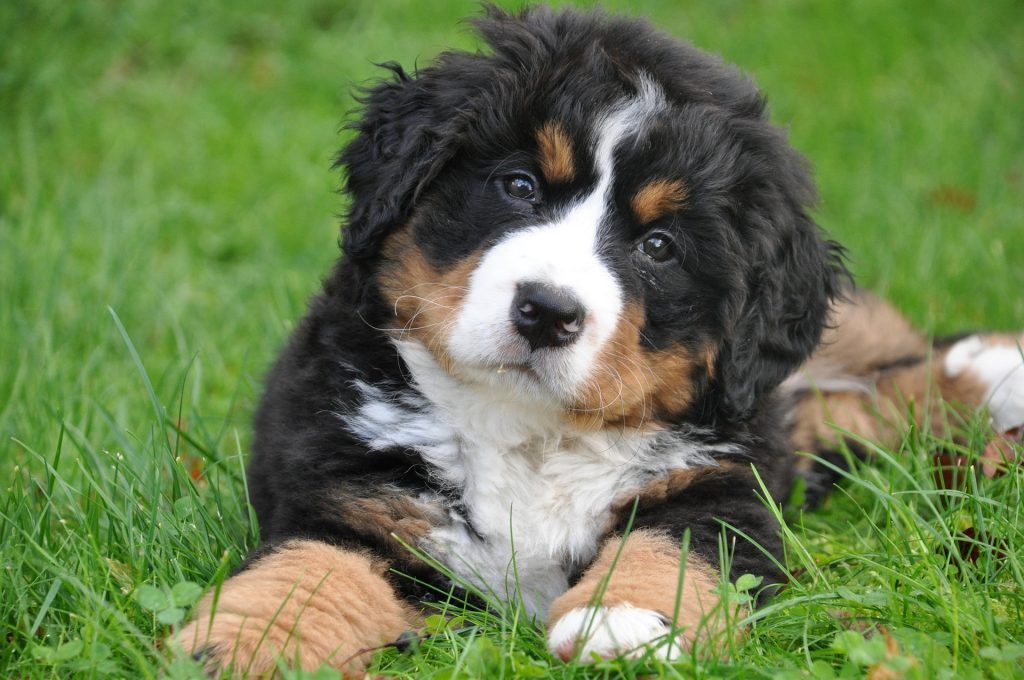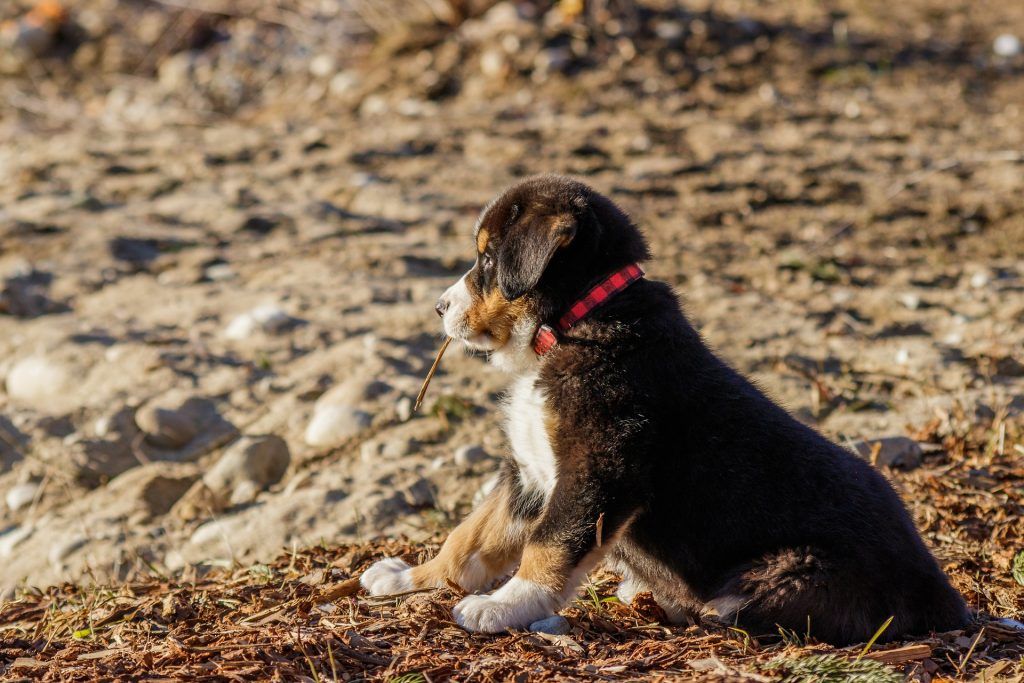Imagine you are lost on a snowy mountain in Switzerland. You are cold, hungry, and scared. You have no idea where you are or how to get back to civilization. You are about to give up hope when you hear a bark. You look up and see a large black dog with white and rust-colored markings running toward you. The dog has a friendly and gentle expression on its face. It nudges you with its nose and licks your face. It then lies down next to you and wraps its warm, furry body around you. You feel a surge of relief and gratitude. You have just met a Bernese Mountain Dog, one of the world’s most loyal and loving breeds.
Affectionately called “The Berner,” this is a strikingly beautiful dog breed with a long, silky coat that is mostly black with white and rust-colored markings. They are gentle and affectionate, making them great family companions. Berners are loyal, intelligent, and eager to please but also need plenty of exercise, socialization, and training to thrive.

History of the Bernese Mountain Dog
The Bernese Mountain Dog is believed to have descended from the ancient Roman mastiffs brought to Switzerland by the invading armies. These dogs were crossed with the local herding dogs to create the Sennenhund breeds. The Berner was developed in the canton of Bern, where it was used as a versatile farm dog that could pull carts, herd cattle, guard property, and provide companionship.
The Berner was not well known outside of Switzerland until the late 19th century, when Professor Albert Heim, a Swiss cynologist, recognized and promoted the breed. Heim also helped to establish the first breed club for the Berner in 1907. The Fédération Cynologique Internationale (FCI) officially recognized the breed in 1913.
The first Berners were imported to the United States in 1926 by a Kansas farmer named John Goff. The American Kennel Club (AKC) recognized the breed in 1937 as part of the Working Group. Today, the Berner ranks 22nd among the 197 breeds and varieties recognized by the AKC in terms of popularity.
Characteristics of the Bernese Mountain Dog
Appearance
The Bernese Mountain Dog is a large and powerful dog that stands between 23 and 27.5 inches at the shoulder and weighs between 70 and 115 pounds. The breed has a sturdy and muscular body with a broad chest and a slightly curved back. The tail is long and bushy and carried low when relaxed or slightly raised when alert.
The head should be strong and well-proportioned, with a flat skull and a moderate stop. The muzzle is straight and strong with a black nose. The ears are medium-sized, triangular, and set high on the head. They hang down close to the cheeks when at rest or slightly raised when attentive. The eyes are almond-shaped, dark brown, and expressive.
The Berners coat is one of its most distinctive features. It is long, silky, and slightly wavy with a thick undercoat. The coat is mostly black with symmetrical white markings on the chest, muzzle, toes, and tail tip. There are also rust or tan markings on the eyebrows, cheeks, chest, legs, and under the tail.
The coat color and pattern are important breed hallmarks that should not be altered or modified in any way. According to the AKC breed standard, “any alteration other than removal of dewclaws is considered mutilation and is a disqualification.”

Personality
The temperament of the Berner is another key characteristic that sets it apart from other breeds. The Berner is a gentle giant that loves people and other animals. The breed is loyal, affectionate, and devoted to its family members. The Berner is also intelligent, trainable, and eager to please its owner.
The breed needs plenty of exercise, socialization, and training to be happy and well-behaved. The Berner can be stubborn, sensitive, or shy if not properly raised or handled. The breed can also suffer from separation anxiety if left alone for too long or too often.
The Berner is best suited for active families with enough time, space, and resources to meet its needs. The breed thrives in rural or suburban environments where it can enjoy outdoor activities such as hiking, camping, or carting. The Berner can adapt to apartment living if given enough exercise, but it prefers to have access to a fenced yard where it can run and play.
Common Health Issues Affecting Bernese Mountain Dogs
The Bernese Mountain Dog is generally healthy and can live up to 10 years or more. Like any large breed, though, it is prone to some health conditions that owners should be aware of.
Some of these conditions include:
- Hip dysplasia: This is a genetic disorder that affects the hip joints of dogs. It causes pain, lameness, arthritis, and reduced mobility. Hip dysplasia can be diagnosed by X-rays and treated by surgery or medication. Owners should look for reputable breeders who test their dogs for hip dysplasia and provide health certificates.
- Elbow dysplasia: This is another genetic disorder that affects the elbow joints of dogs. It causes pain, lameness, arthritis, and reduced mobility. Elbow dysplasia can be diagnosed by X-rays and treated by surgery or medication. Owners should look for reputable breeders who test their dogs for elbow dysplasia and provide health certificates.
- Gastric dilatation-volvulus (GDV): This life-threatening condition, commonly known as bloat, occurs when the stomach twists on itself and traps gas inside. Not treated immediately causes bloating, pain, shock, and death. GDV can be prevented by feeding small meals throughout the day, avoiding exercise after eating, and raising the food bowl off the ground. Owners should seek emergency veterinary care if they notice signs of GDV, such as restlessness, drooling, retching, or abdominal distension.
- Cancer: This is a common cause of death among Berners. The most common types of cancer that affect the breed are histiocytic sarcoma, osteosarcoma, lymphoma, and mast cell tumor. Cancer can be diagnosed by biopsy and treated by surgery, chemotherapy, or radiation therapy. Owners should monitor their dogs for any lumps, bumps, or changes in behavior and consult their veterinarian if they notice anything suspicious.
- Blood disorders: There are rare but serious conditions that affect dogs’ blood cells or clotting factors. They include von Willebrand’s disease (vWD), hemophilia A, and hemolytic anemia. Blood disorders can cause bleeding, bruising, anemia, or weakness. They can be diagnosed by blood tests and treated by transfusion or medication. Owners should look for reputable breeders who test their dogs for blood disorders and provide health certificates.
Other health issues that may affect the Berner include eye diseases such as cataracts, progressive retinal atrophy (PRA), or entropion; skin problems such as allergies, hot spots, or pyoderma; or thyroid problems such as hypothyroidism or hyperthyroidism.
Caring For A Bernese Mountain Dog
Bernese Mountain Dogs require moderate grooming, exercise, and training maintenance. Most of it is pretty basic and similar to what you’d find with any dog breed.
Grooming
The long coat of the Berner needs weekly brushing to prevent mats, tangles, and shedding. The coat should also be trimmed around the feet, ears, and tail to keep it neat and clean. The ears should be checked regularly for dirt, wax, or infection and cleaned gently with a cotton ball or a soft cloth. The nails should be trimmed monthly to prevent cracking or splitting. The teeth should be brushed daily or at least weekly to prevent plaque or tartar buildup.

Exercise
The Berner needs at least an hour of daily exercise to stay fit and healthy. The exercise should include walks, jogs, hikes, or play sessions with other dogs or people. The exercise should also vary in intensity and duration to keep it interesting and challenging for the dog. The exercise should be done in cool weather or early morning or evening hours to avoid overheating or dehydration. The dog should always have access to fresh water and shade when outdoors.
Training
The Berner needs early socialization and training to become a well-rounded and well-behaved dog. Socialization involves exposing the dog to different people, animals, situations, and environments in a positive and controlled manner, which helps the dog develop confidence, curiosity, and friendliness toward others. Training involves teaching the dog basic commands, manners, and skills using positive reinforcement, consistency, and patience. Training helps the dog learn what is expected of it, how to communicate with its owner, and how to have fun with its owner.
Socialization
Training also strengthens the bond between the dog and its owner. The Berner is a smart and eager learner that responds well to praise, treats, and toys. The Berner can learn a variety of tricks, games, and tasks that can challenge its mind and body. The Berner can also participate in dog sports such as agility, obedience, or rally. However, the Berner can also be stubborn, sensitive, or shy if not properly raised or handled. Berners need a firm, gentle leader who can provide clear, consistent rules and boundaries. The Berner also needs a lot of socialization and exposure to different stimuli to prevent fearfulness, anxiety, or aggression. The Berner should never be harshly punished, yelled at, or hit, as this can damage its trust and confidence.
Interesting Facts About Bernese Mountain Dogs
The Bernese Mountain Dog is a fascinating breed that has many interesting facts and features. Here are some you might not have known:
- The Berner is one of the few breeds with a tri-color coat, always black, white, and rust. The coat pattern is genetically determined and does not vary much among individuals.
- The Berner is one of the four types of Sennenhund, or Swiss mountain dogs, that share a common ancestry and appearance. The other three are the Appenzeller Sennenhund, the Entlebucher Sennenhund, and the Greater Swiss Mountain Dog. The Berner is the only one that has a long coat.
- The Berner is named after the canton of Bern in Switzerland, where it was developed as a farm dog. The name Sennenhund means “dog of the Alpine herders” in German. The name Berner Sennenhund means “Bernese Alpine herder’s dog.”
- The Berner is a hardy dog that can withstand cold and snowy weather. The breed was originally used to pull carts loaded with milk, cheese, or meat from the farms to the markets. The breed can still perform this task today and enjoys carting as a hobby or sport.
- The Berner is a gentle, affectionate dog that loves children and animals. The breed has a strong protective instinct and will alert its owner to any strangers or dangers. The breed is not aggressive but will defend its family if necessary.
- The Berner is a loyal and devoted dog that forms a deep bond with its owner. The breed suffers from separation anxiety if left alone for too long or too often. The breed needs to be part of the family and involved in its activities.
- The Berner is an intelligent and trainable dog that can learn many skills and commands. The breed has a natural talent for herding and can work well with cattle, sheep, or goats. The breed can also excel in dog sports such as agility, obedience, or rally.
- The Berner is a playful and fun-loving dog that enjoys games and toys. The breed has a goofy and clownish personality that can make anyone laugh. They like to chase, fetch, tug, or cuddle with their owner.

Where to Buy a Bernese Mountain Dog
The Bernese Mountain Dog is not a very common breed in the United States, but it is not impossible to find one. The average price of a Berner puppy from a reputable breeder is between $1,000 and $2,000, depending on the breeder’s quality, pedigree, and location. The breed is also sometimes available for adoption from rescue groups or shelters, but this is rare and may require a long waiting list.
You can find a list of reputable Berner breeders and rescue groups on the Bernese Mountain Dog Club of America (BMDCA) websites or the American Kennel Club (AKC). You can also contact local Berner clubs or veterinarians for referrals or recommendations. Be prepared to answer some questions and fill out some forms before getting approved for a Berner puppy or dog.
Conclusion
The Bernese Mountain Dog is a wonderful breed that can make a great family companion for the right owner. The breed is beautiful, gentle, loyal, intelligent, and fun-loving. The breed does have some challenges and requirements, but fortunately, they aren’t too difficult. If you can commit to meeting the needs of the Berner and providing it with a loving and caring home, then you may have found your perfect match; and be rewarded with its unconditional love, loyalty, and companionship for many years to come.
More Dog Breeds
If you’re interested in learning about similar dog breeds, check out:
FAQ
Do Bernese Mountain Dogs shed?
Yes, Bernese Mountain Dogs shed a lot, especially in the spring and fall, when they blow their undercoat. They need weekly brushing to remove loose hair and prevent mats and tangles.
How much is a Bernese Mountain Dog?
The average price of a Bernese Mountain Dog puppy from a reputable breeder is between $1,000 and $2,000.
Do Bernese Mountain Dogs drool?
No, Bernese Mountain Dogs do not drool excessively, unlike some other large breeds. However, they may drool a little after drinking water or eating food. You should keep a towel handy to wipe their mouth if needed…unless you like sloppy kisses.
How big do Bernese Mountain Dogs get?
Bernese Mountain Dogs are large dogs that stand between 23 and 27.5 inches at the shoulder and weigh between 70 and 115 pounds. They have a sturdy, muscular body, broad chest, and slightly curved back.
Are Bernese Mountain Dogs smart?
Yes, Bernese Mountain Dogs are smart and eager to please their owners. They can learn many skills and commands with positive reinforcement, consistency, and patience. They also have a natural talent for herding and can work well with cattle, sheep, or goats.
























